Research: Employee Satisfaction, Retention at Cowshed Spa Shoreditch
VerifiedAdded on 2024/04/26
|41
|7434
|356
Project
AI Summary
This business research project investigates employee satisfaction, retention, and turnover rates at Cowshed Spa Shoreditch. The research employs both quantitative and qualitative data collection methods, including questionnaires and interviews with employees and managers. The questionnaire design incorporates scaled questions to assess employee perceptions of endorsement and pay revision systems. Data analysis involves statistical methods to derive insights from the collected data. The project evaluates the effectiveness of current employee relations practices, identifies areas for improvement, and offers recommendations for enhancing employee satisfaction and reducing turnover. Difficulties encountered during the research process are also discussed, providing a comprehensive overview of the project's methodology, findings, and implications for Cowshed Spa Shoreditch.
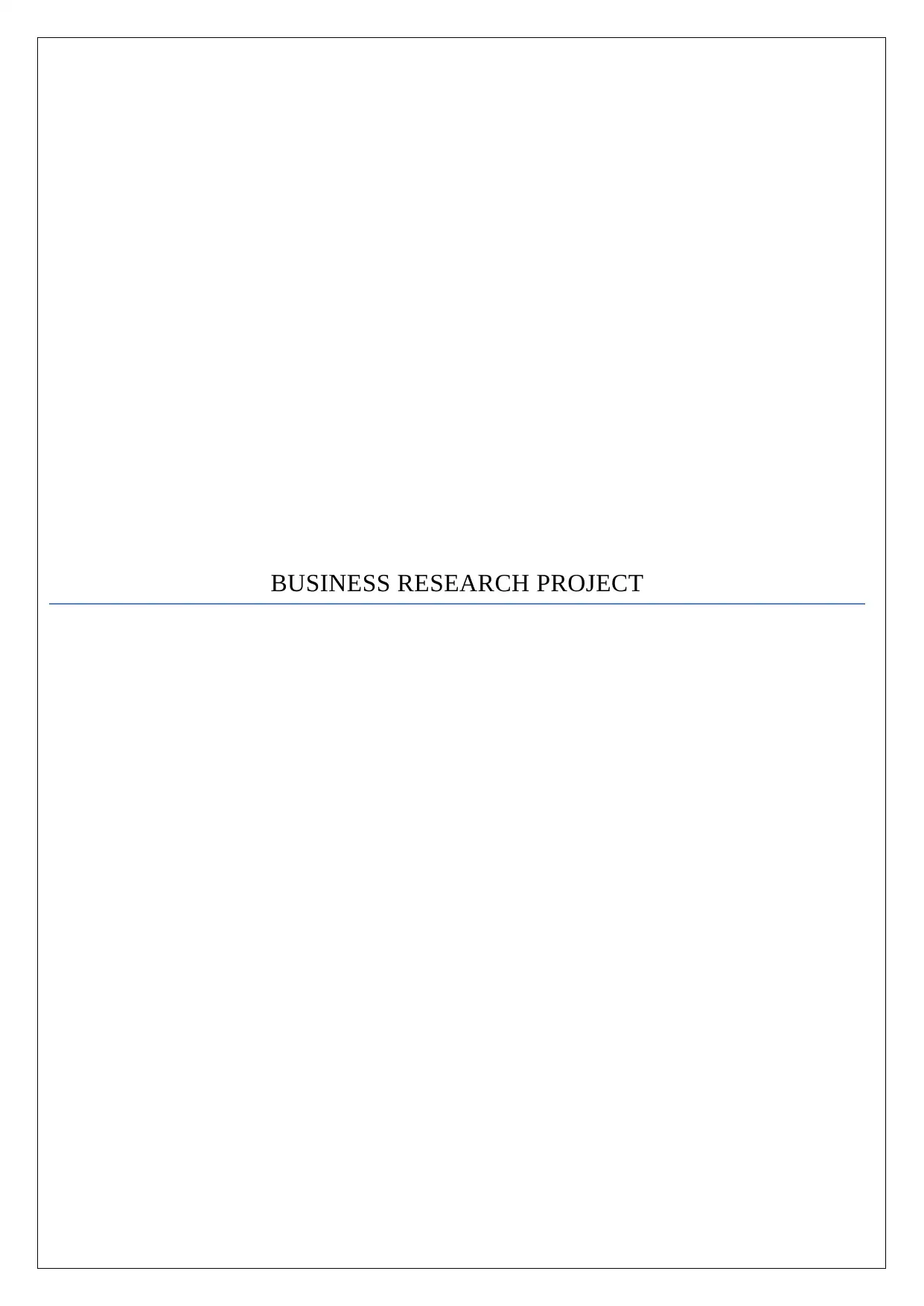
BUSINESS RESEARCH PROJECT
Paraphrase This Document
Need a fresh take? Get an instant paraphrase of this document with our AI Paraphraser
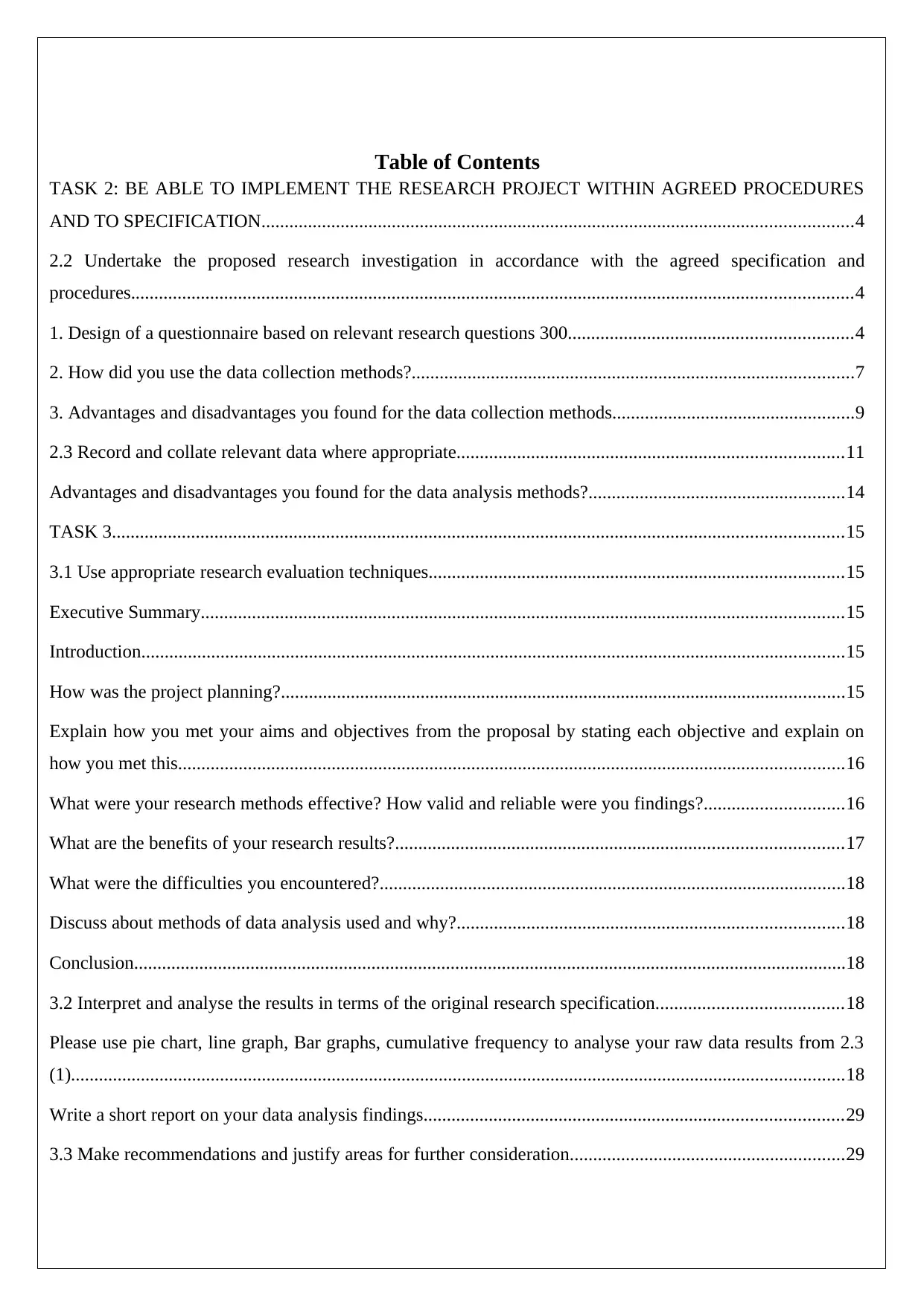
Table of Contents
TASK 2: BE ABLE TO IMPLEMENT THE RESEARCH PROJECT WITHIN AGREED PROCEDURES
AND TO SPECIFICATION...............................................................................................................................4
2.2 Undertake the proposed research investigation in accordance with the agreed specification and
procedures...........................................................................................................................................................4
1. Design of a questionnaire based on relevant research questions 300.............................................................4
2. How did you use the data collection methods?...............................................................................................7
3. Advantages and disadvantages you found for the data collection methods....................................................9
2.3 Record and collate relevant data where appropriate...................................................................................11
Advantages and disadvantages you found for the data analysis methods?.......................................................14
TASK 3.............................................................................................................................................................15
3.1 Use appropriate research evaluation techniques.........................................................................................15
Executive Summary..........................................................................................................................................15
Introduction.......................................................................................................................................................15
How was the project planning?.........................................................................................................................15
Explain how you met your aims and objectives from the proposal by stating each objective and explain on
how you met this...............................................................................................................................................16
What were your research methods effective? How valid and reliable were you findings?..............................16
What are the benefits of your research results?................................................................................................17
What were the difficulties you encountered?....................................................................................................18
Discuss about methods of data analysis used and why?...................................................................................18
Conclusion.........................................................................................................................................................18
3.2 Interpret and analyse the results in terms of the original research specification........................................18
Please use pie chart, line graph, Bar graphs, cumulative frequency to analyse your raw data results from 2.3
(1)......................................................................................................................................................................18
Write a short report on your data analysis findings..........................................................................................29
3.3 Make recommendations and justify areas for further consideration...........................................................29
TASK 2: BE ABLE TO IMPLEMENT THE RESEARCH PROJECT WITHIN AGREED PROCEDURES
AND TO SPECIFICATION...............................................................................................................................4
2.2 Undertake the proposed research investigation in accordance with the agreed specification and
procedures...........................................................................................................................................................4
1. Design of a questionnaire based on relevant research questions 300.............................................................4
2. How did you use the data collection methods?...............................................................................................7
3. Advantages and disadvantages you found for the data collection methods....................................................9
2.3 Record and collate relevant data where appropriate...................................................................................11
Advantages and disadvantages you found for the data analysis methods?.......................................................14
TASK 3.............................................................................................................................................................15
3.1 Use appropriate research evaluation techniques.........................................................................................15
Executive Summary..........................................................................................................................................15
Introduction.......................................................................................................................................................15
How was the project planning?.........................................................................................................................15
Explain how you met your aims and objectives from the proposal by stating each objective and explain on
how you met this...............................................................................................................................................16
What were your research methods effective? How valid and reliable were you findings?..............................16
What are the benefits of your research results?................................................................................................17
What were the difficulties you encountered?....................................................................................................18
Discuss about methods of data analysis used and why?...................................................................................18
Conclusion.........................................................................................................................................................18
3.2 Interpret and analyse the results in terms of the original research specification........................................18
Please use pie chart, line graph, Bar graphs, cumulative frequency to analyse your raw data results from 2.3
(1)......................................................................................................................................................................18
Write a short report on your data analysis findings..........................................................................................29
3.3 Make recommendations and justify areas for further consideration...........................................................29
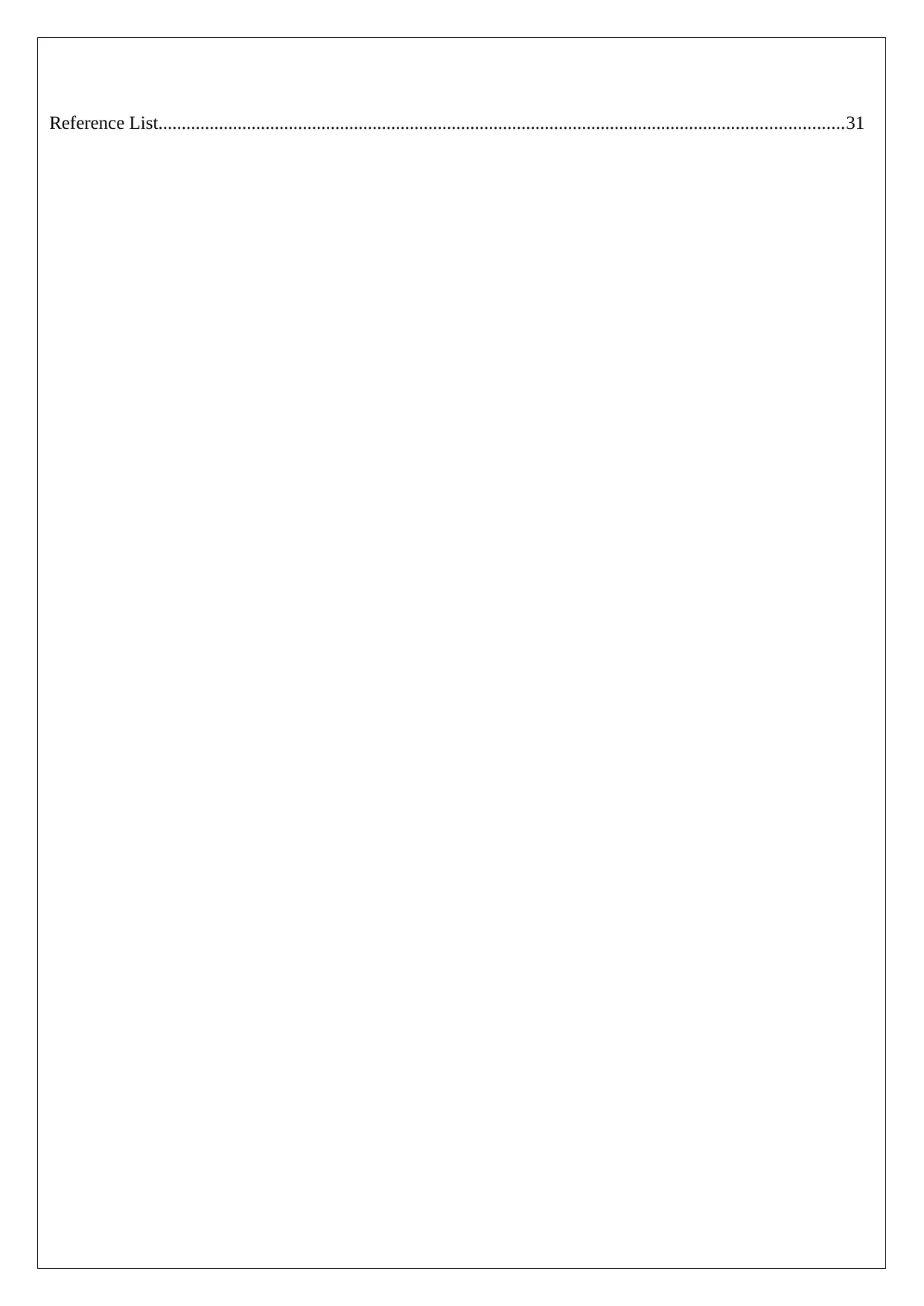
Reference List...................................................................................................................................................31
⊘ This is a preview!⊘
Do you want full access?
Subscribe today to unlock all pages.

Trusted by 1+ million students worldwide
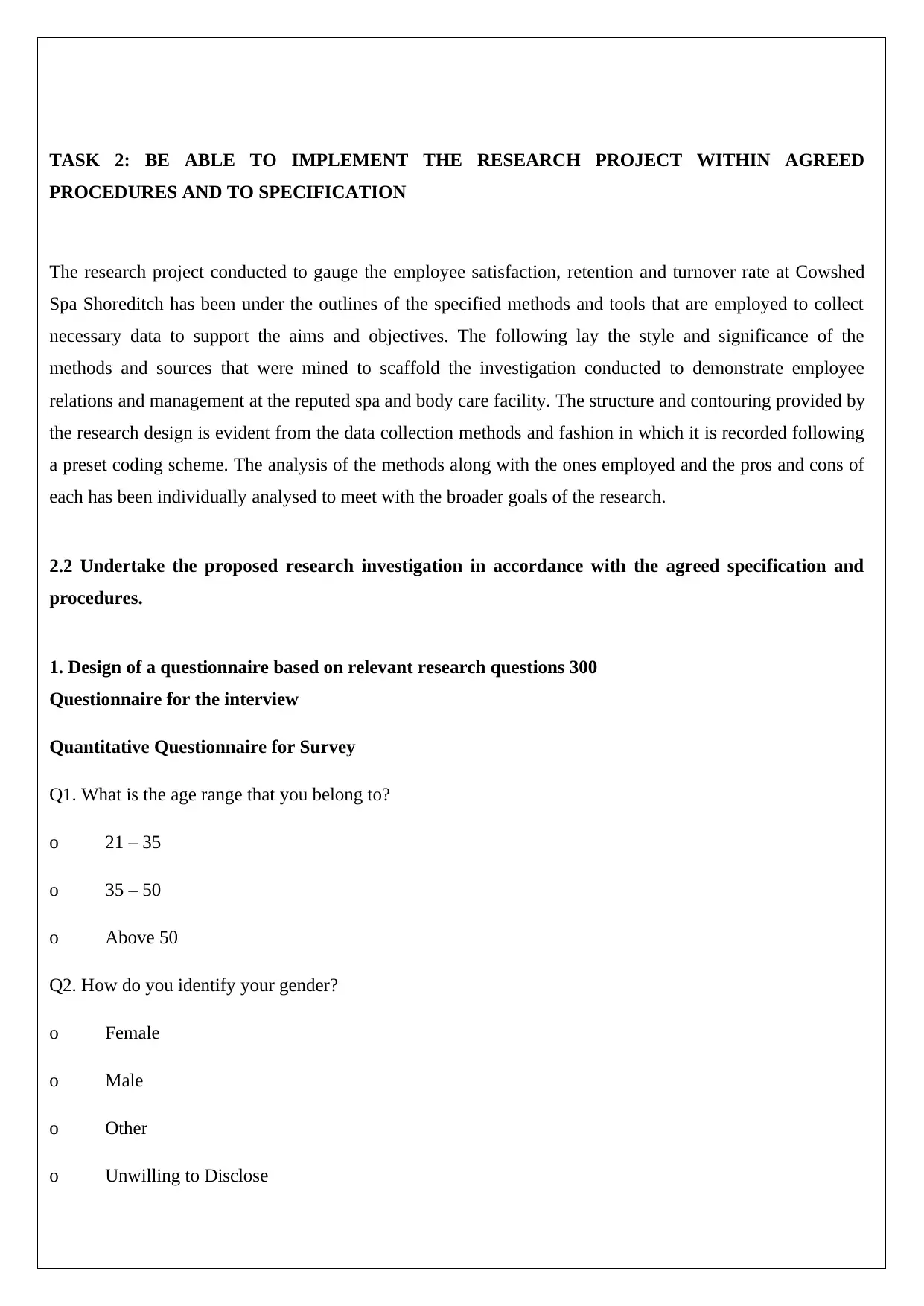
TASK 2: BE ABLE TO IMPLEMENT THE RESEARCH PROJECT WITHIN AGREED
PROCEDURES AND TO SPECIFICATION
The research project conducted to gauge the employee satisfaction, retention and turnover rate at Cowshed
Spa Shoreditch has been under the outlines of the specified methods and tools that are employed to collect
necessary data to support the aims and objectives. The following lay the style and significance of the
methods and sources that were mined to scaffold the investigation conducted to demonstrate employee
relations and management at the reputed spa and body care facility. The structure and contouring provided by
the research design is evident from the data collection methods and fashion in which it is recorded following
a preset coding scheme. The analysis of the methods along with the ones employed and the pros and cons of
each has been individually analysed to meet with the broader goals of the research.
2.2 Undertake the proposed research investigation in accordance with the agreed specification and
procedures.
1. Design of a questionnaire based on relevant research questions 300
Questionnaire for the interview
Quantitative Questionnaire for Survey
Q1. What is the age range that you belong to?
o 21 – 35
o 35 – 50
o Above 50
Q2. How do you identify your gender?
o Female
o Male
o Other
o Unwilling to Disclose
PROCEDURES AND TO SPECIFICATION
The research project conducted to gauge the employee satisfaction, retention and turnover rate at Cowshed
Spa Shoreditch has been under the outlines of the specified methods and tools that are employed to collect
necessary data to support the aims and objectives. The following lay the style and significance of the
methods and sources that were mined to scaffold the investigation conducted to demonstrate employee
relations and management at the reputed spa and body care facility. The structure and contouring provided by
the research design is evident from the data collection methods and fashion in which it is recorded following
a preset coding scheme. The analysis of the methods along with the ones employed and the pros and cons of
each has been individually analysed to meet with the broader goals of the research.
2.2 Undertake the proposed research investigation in accordance with the agreed specification and
procedures.
1. Design of a questionnaire based on relevant research questions 300
Questionnaire for the interview
Quantitative Questionnaire for Survey
Q1. What is the age range that you belong to?
o 21 – 35
o 35 – 50
o Above 50
Q2. How do you identify your gender?
o Female
o Male
o Other
o Unwilling to Disclose
Paraphrase This Document
Need a fresh take? Get an instant paraphrase of this document with our AI Paraphraser
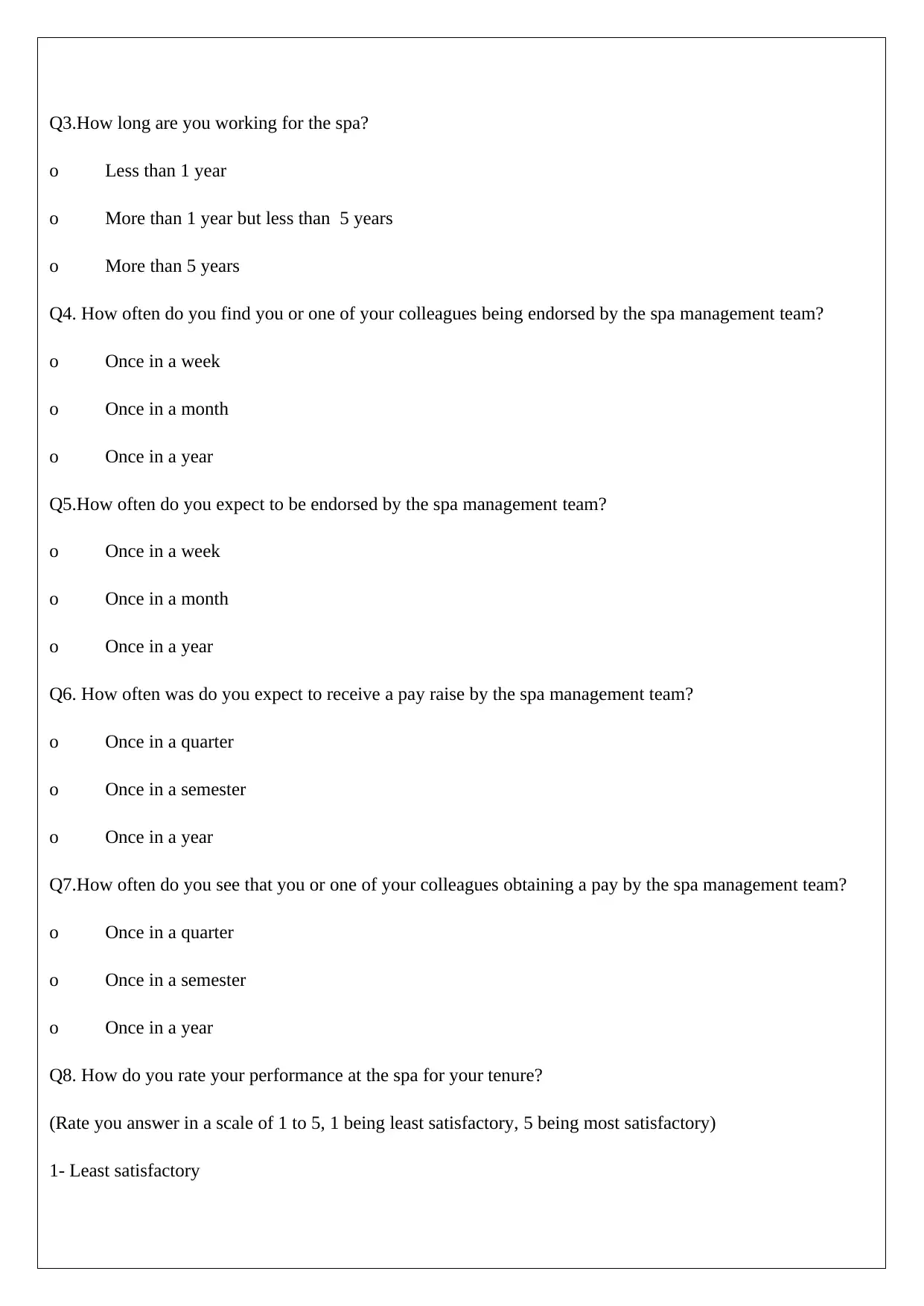
Q3.How long are you working for the spa?
o Less than 1 year
o More than 1 year but less than 5 years
o More than 5 years
Q4. How often do you find you or one of your colleagues being endorsed by the spa management team?
o Once in a week
o Once in a month
o Once in a year
Q5.How often do you expect to be endorsed by the spa management team?
o Once in a week
o Once in a month
o Once in a year
Q6. How often was do you expect to receive a pay raise by the spa management team?
o Once in a quarter
o Once in a semester
o Once in a year
Q7.How often do you see that you or one of your colleagues obtaining a pay by the spa management team?
o Once in a quarter
o Once in a semester
o Once in a year
Q8. How do you rate your performance at the spa for your tenure?
(Rate you answer in a scale of 1 to 5, 1 being least satisfactory, 5 being most satisfactory)
1- Least satisfactory
o Less than 1 year
o More than 1 year but less than 5 years
o More than 5 years
Q4. How often do you find you or one of your colleagues being endorsed by the spa management team?
o Once in a week
o Once in a month
o Once in a year
Q5.How often do you expect to be endorsed by the spa management team?
o Once in a week
o Once in a month
o Once in a year
Q6. How often was do you expect to receive a pay raise by the spa management team?
o Once in a quarter
o Once in a semester
o Once in a year
Q7.How often do you see that you or one of your colleagues obtaining a pay by the spa management team?
o Once in a quarter
o Once in a semester
o Once in a year
Q8. How do you rate your performance at the spa for your tenure?
(Rate you answer in a scale of 1 to 5, 1 being least satisfactory, 5 being most satisfactory)
1- Least satisfactory
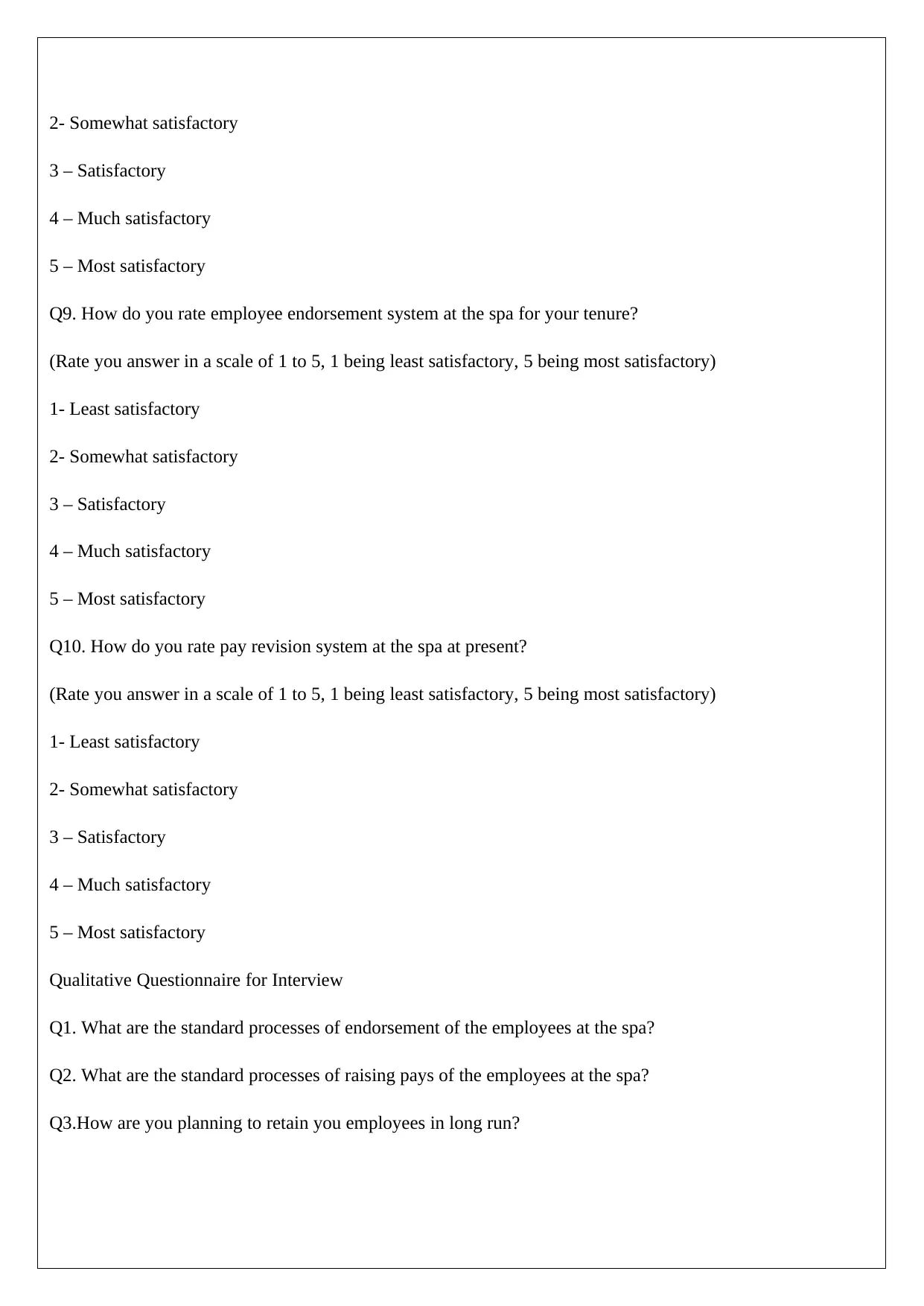
2- Somewhat satisfactory
3 – Satisfactory
4 – Much satisfactory
5 – Most satisfactory
Q9. How do you rate employee endorsement system at the spa for your tenure?
(Rate you answer in a scale of 1 to 5, 1 being least satisfactory, 5 being most satisfactory)
1- Least satisfactory
2- Somewhat satisfactory
3 – Satisfactory
4 – Much satisfactory
5 – Most satisfactory
Q10. How do you rate pay revision system at the spa at present?
(Rate you answer in a scale of 1 to 5, 1 being least satisfactory, 5 being most satisfactory)
1- Least satisfactory
2- Somewhat satisfactory
3 – Satisfactory
4 – Much satisfactory
5 – Most satisfactory
Qualitative Questionnaire for Interview
Q1. What are the standard processes of endorsement of the employees at the spa?
Q2. What are the standard processes of raising pays of the employees at the spa?
Q3.How are you planning to retain you employees in long run?
3 – Satisfactory
4 – Much satisfactory
5 – Most satisfactory
Q9. How do you rate employee endorsement system at the spa for your tenure?
(Rate you answer in a scale of 1 to 5, 1 being least satisfactory, 5 being most satisfactory)
1- Least satisfactory
2- Somewhat satisfactory
3 – Satisfactory
4 – Much satisfactory
5 – Most satisfactory
Q10. How do you rate pay revision system at the spa at present?
(Rate you answer in a scale of 1 to 5, 1 being least satisfactory, 5 being most satisfactory)
1- Least satisfactory
2- Somewhat satisfactory
3 – Satisfactory
4 – Much satisfactory
5 – Most satisfactory
Qualitative Questionnaire for Interview
Q1. What are the standard processes of endorsement of the employees at the spa?
Q2. What are the standard processes of raising pays of the employees at the spa?
Q3.How are you planning to retain you employees in long run?
⊘ This is a preview!⊘
Do you want full access?
Subscribe today to unlock all pages.

Trusted by 1+ million students worldwide
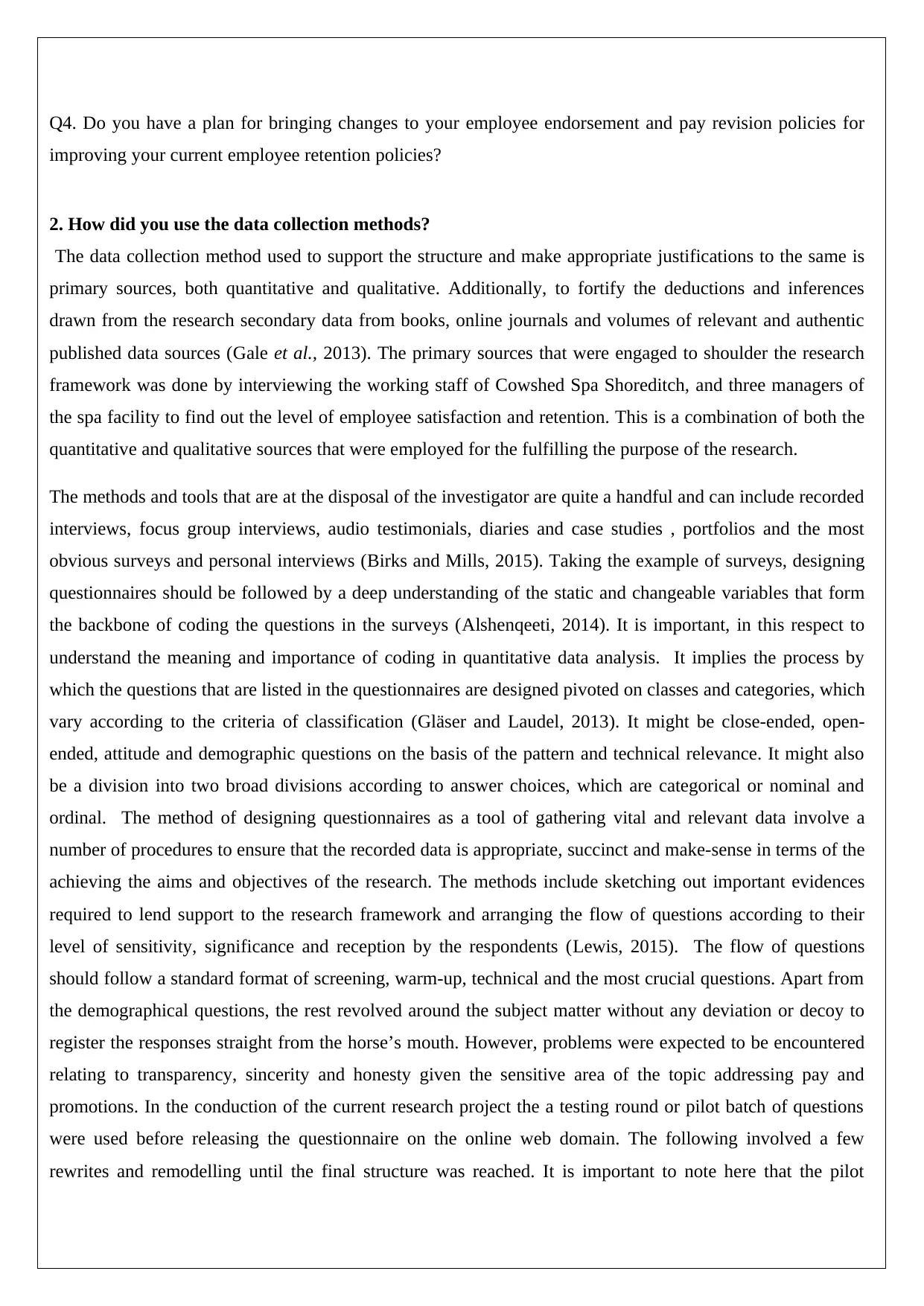
Q4. Do you have a plan for bringing changes to your employee endorsement and pay revision policies for
improving your current employee retention policies?
2. How did you use the data collection methods?
The data collection method used to support the structure and make appropriate justifications to the same is
primary sources, both quantitative and qualitative. Additionally, to fortify the deductions and inferences
drawn from the research secondary data from books, online journals and volumes of relevant and authentic
published data sources (Gale et al., 2013). The primary sources that were engaged to shoulder the research
framework was done by interviewing the working staff of Cowshed Spa Shoreditch, and three managers of
the spa facility to find out the level of employee satisfaction and retention. This is a combination of both the
quantitative and qualitative sources that were employed for the fulfilling the purpose of the research.
The methods and tools that are at the disposal of the investigator are quite a handful and can include recorded
interviews, focus group interviews, audio testimonials, diaries and case studies , portfolios and the most
obvious surveys and personal interviews (Birks and Mills, 2015). Taking the example of surveys, designing
questionnaires should be followed by a deep understanding of the static and changeable variables that form
the backbone of coding the questions in the surveys (Alshenqeeti, 2014). It is important, in this respect to
understand the meaning and importance of coding in quantitative data analysis. It implies the process by
which the questions that are listed in the questionnaires are designed pivoted on classes and categories, which
vary according to the criteria of classification (Gläser and Laudel, 2013). It might be close-ended, open-
ended, attitude and demographic questions on the basis of the pattern and technical relevance. It might also
be a division into two broad divisions according to answer choices, which are categorical or nominal and
ordinal. The method of designing questionnaires as a tool of gathering vital and relevant data involve a
number of procedures to ensure that the recorded data is appropriate, succinct and make-sense in terms of the
achieving the aims and objectives of the research. The methods include sketching out important evidences
required to lend support to the research framework and arranging the flow of questions according to their
level of sensitivity, significance and reception by the respondents (Lewis, 2015). The flow of questions
should follow a standard format of screening, warm-up, technical and the most crucial questions. Apart from
the demographical questions, the rest revolved around the subject matter without any deviation or decoy to
register the responses straight from the horse’s mouth. However, problems were expected to be encountered
relating to transparency, sincerity and honesty given the sensitive area of the topic addressing pay and
promotions. In the conduction of the current research project the a testing round or pilot batch of questions
were used before releasing the questionnaire on the online web domain. The following involved a few
rewrites and remodelling until the final structure was reached. It is important to note here that the pilot
improving your current employee retention policies?
2. How did you use the data collection methods?
The data collection method used to support the structure and make appropriate justifications to the same is
primary sources, both quantitative and qualitative. Additionally, to fortify the deductions and inferences
drawn from the research secondary data from books, online journals and volumes of relevant and authentic
published data sources (Gale et al., 2013). The primary sources that were engaged to shoulder the research
framework was done by interviewing the working staff of Cowshed Spa Shoreditch, and three managers of
the spa facility to find out the level of employee satisfaction and retention. This is a combination of both the
quantitative and qualitative sources that were employed for the fulfilling the purpose of the research.
The methods and tools that are at the disposal of the investigator are quite a handful and can include recorded
interviews, focus group interviews, audio testimonials, diaries and case studies , portfolios and the most
obvious surveys and personal interviews (Birks and Mills, 2015). Taking the example of surveys, designing
questionnaires should be followed by a deep understanding of the static and changeable variables that form
the backbone of coding the questions in the surveys (Alshenqeeti, 2014). It is important, in this respect to
understand the meaning and importance of coding in quantitative data analysis. It implies the process by
which the questions that are listed in the questionnaires are designed pivoted on classes and categories, which
vary according to the criteria of classification (Gläser and Laudel, 2013). It might be close-ended, open-
ended, attitude and demographic questions on the basis of the pattern and technical relevance. It might also
be a division into two broad divisions according to answer choices, which are categorical or nominal and
ordinal. The method of designing questionnaires as a tool of gathering vital and relevant data involve a
number of procedures to ensure that the recorded data is appropriate, succinct and make-sense in terms of the
achieving the aims and objectives of the research. The methods include sketching out important evidences
required to lend support to the research framework and arranging the flow of questions according to their
level of sensitivity, significance and reception by the respondents (Lewis, 2015). The flow of questions
should follow a standard format of screening, warm-up, technical and the most crucial questions. Apart from
the demographical questions, the rest revolved around the subject matter without any deviation or decoy to
register the responses straight from the horse’s mouth. However, problems were expected to be encountered
relating to transparency, sincerity and honesty given the sensitive area of the topic addressing pay and
promotions. In the conduction of the current research project the a testing round or pilot batch of questions
were used before releasing the questionnaire on the online web domain. The following involved a few
rewrites and remodelling until the final structure was reached. It is important to note here that the pilot
Paraphrase This Document
Need a fresh take? Get an instant paraphrase of this document with our AI Paraphraser
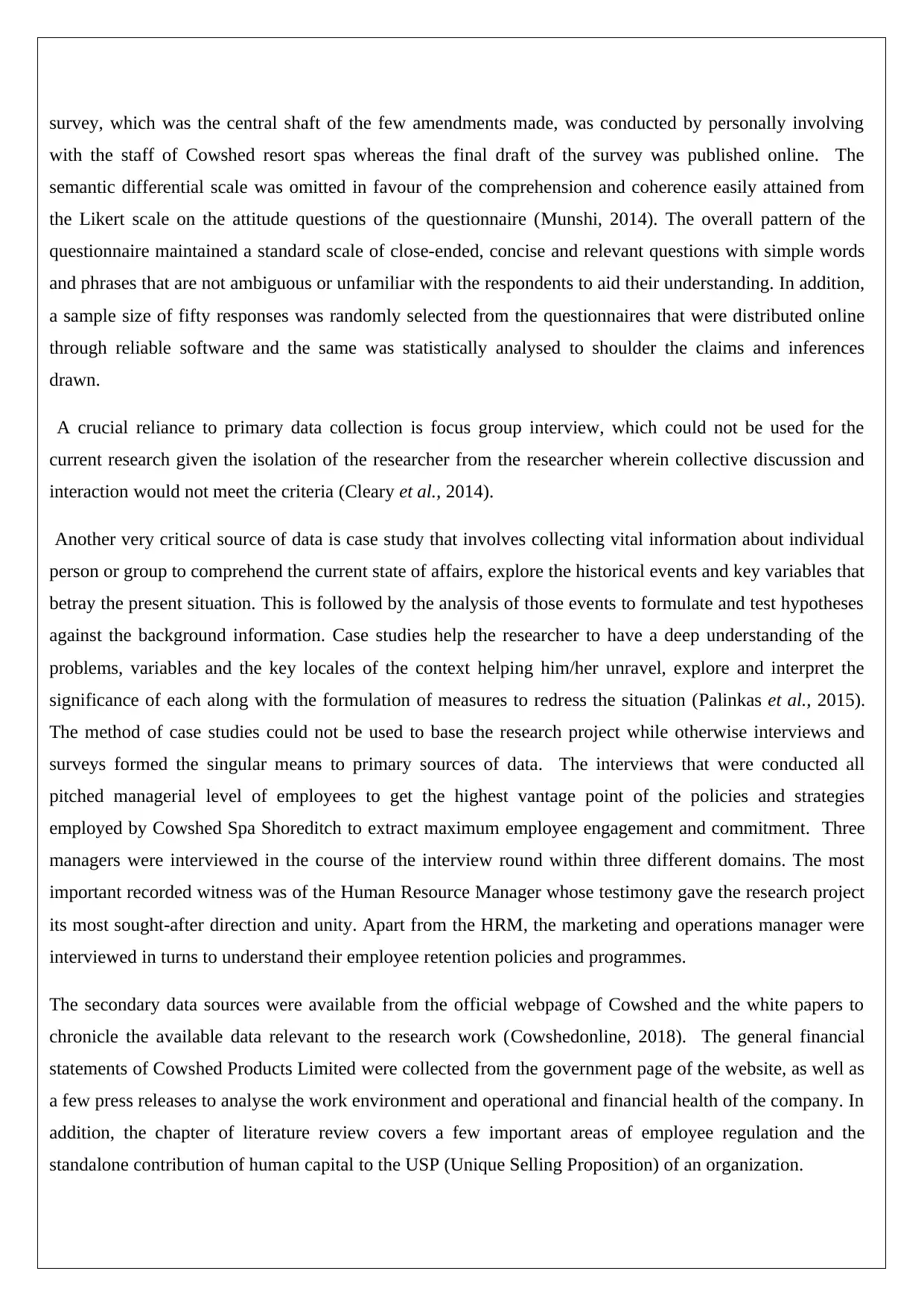
survey, which was the central shaft of the few amendments made, was conducted by personally involving
with the staff of Cowshed resort spas whereas the final draft of the survey was published online. The
semantic differential scale was omitted in favour of the comprehension and coherence easily attained from
the Likert scale on the attitude questions of the questionnaire (Munshi, 2014). The overall pattern of the
questionnaire maintained a standard scale of close-ended, concise and relevant questions with simple words
and phrases that are not ambiguous or unfamiliar with the respondents to aid their understanding. In addition,
a sample size of fifty responses was randomly selected from the questionnaires that were distributed online
through reliable software and the same was statistically analysed to shoulder the claims and inferences
drawn.
A crucial reliance to primary data collection is focus group interview, which could not be used for the
current research given the isolation of the researcher from the researcher wherein collective discussion and
interaction would not meet the criteria (Cleary et al., 2014).
Another very critical source of data is case study that involves collecting vital information about individual
person or group to comprehend the current state of affairs, explore the historical events and key variables that
betray the present situation. This is followed by the analysis of those events to formulate and test hypotheses
against the background information. Case studies help the researcher to have a deep understanding of the
problems, variables and the key locales of the context helping him/her unravel, explore and interpret the
significance of each along with the formulation of measures to redress the situation (Palinkas et al., 2015).
The method of case studies could not be used to base the research project while otherwise interviews and
surveys formed the singular means to primary sources of data. The interviews that were conducted all
pitched managerial level of employees to get the highest vantage point of the policies and strategies
employed by Cowshed Spa Shoreditch to extract maximum employee engagement and commitment. Three
managers were interviewed in the course of the interview round within three different domains. The most
important recorded witness was of the Human Resource Manager whose testimony gave the research project
its most sought-after direction and unity. Apart from the HRM, the marketing and operations manager were
interviewed in turns to understand their employee retention policies and programmes.
The secondary data sources were available from the official webpage of Cowshed and the white papers to
chronicle the available data relevant to the research work (Cowshedonline, 2018). The general financial
statements of Cowshed Products Limited were collected from the government page of the website, as well as
a few press releases to analyse the work environment and operational and financial health of the company. In
addition, the chapter of literature review covers a few important areas of employee regulation and the
standalone contribution of human capital to the USP (Unique Selling Proposition) of an organization.
with the staff of Cowshed resort spas whereas the final draft of the survey was published online. The
semantic differential scale was omitted in favour of the comprehension and coherence easily attained from
the Likert scale on the attitude questions of the questionnaire (Munshi, 2014). The overall pattern of the
questionnaire maintained a standard scale of close-ended, concise and relevant questions with simple words
and phrases that are not ambiguous or unfamiliar with the respondents to aid their understanding. In addition,
a sample size of fifty responses was randomly selected from the questionnaires that were distributed online
through reliable software and the same was statistically analysed to shoulder the claims and inferences
drawn.
A crucial reliance to primary data collection is focus group interview, which could not be used for the
current research given the isolation of the researcher from the researcher wherein collective discussion and
interaction would not meet the criteria (Cleary et al., 2014).
Another very critical source of data is case study that involves collecting vital information about individual
person or group to comprehend the current state of affairs, explore the historical events and key variables that
betray the present situation. This is followed by the analysis of those events to formulate and test hypotheses
against the background information. Case studies help the researcher to have a deep understanding of the
problems, variables and the key locales of the context helping him/her unravel, explore and interpret the
significance of each along with the formulation of measures to redress the situation (Palinkas et al., 2015).
The method of case studies could not be used to base the research project while otherwise interviews and
surveys formed the singular means to primary sources of data. The interviews that were conducted all
pitched managerial level of employees to get the highest vantage point of the policies and strategies
employed by Cowshed Spa Shoreditch to extract maximum employee engagement and commitment. Three
managers were interviewed in the course of the interview round within three different domains. The most
important recorded witness was of the Human Resource Manager whose testimony gave the research project
its most sought-after direction and unity. Apart from the HRM, the marketing and operations manager were
interviewed in turns to understand their employee retention policies and programmes.
The secondary data sources were available from the official webpage of Cowshed and the white papers to
chronicle the available data relevant to the research work (Cowshedonline, 2018). The general financial
statements of Cowshed Products Limited were collected from the government page of the website, as well as
a few press releases to analyse the work environment and operational and financial health of the company. In
addition, the chapter of literature review covers a few important areas of employee regulation and the
standalone contribution of human capital to the USP (Unique Selling Proposition) of an organization.
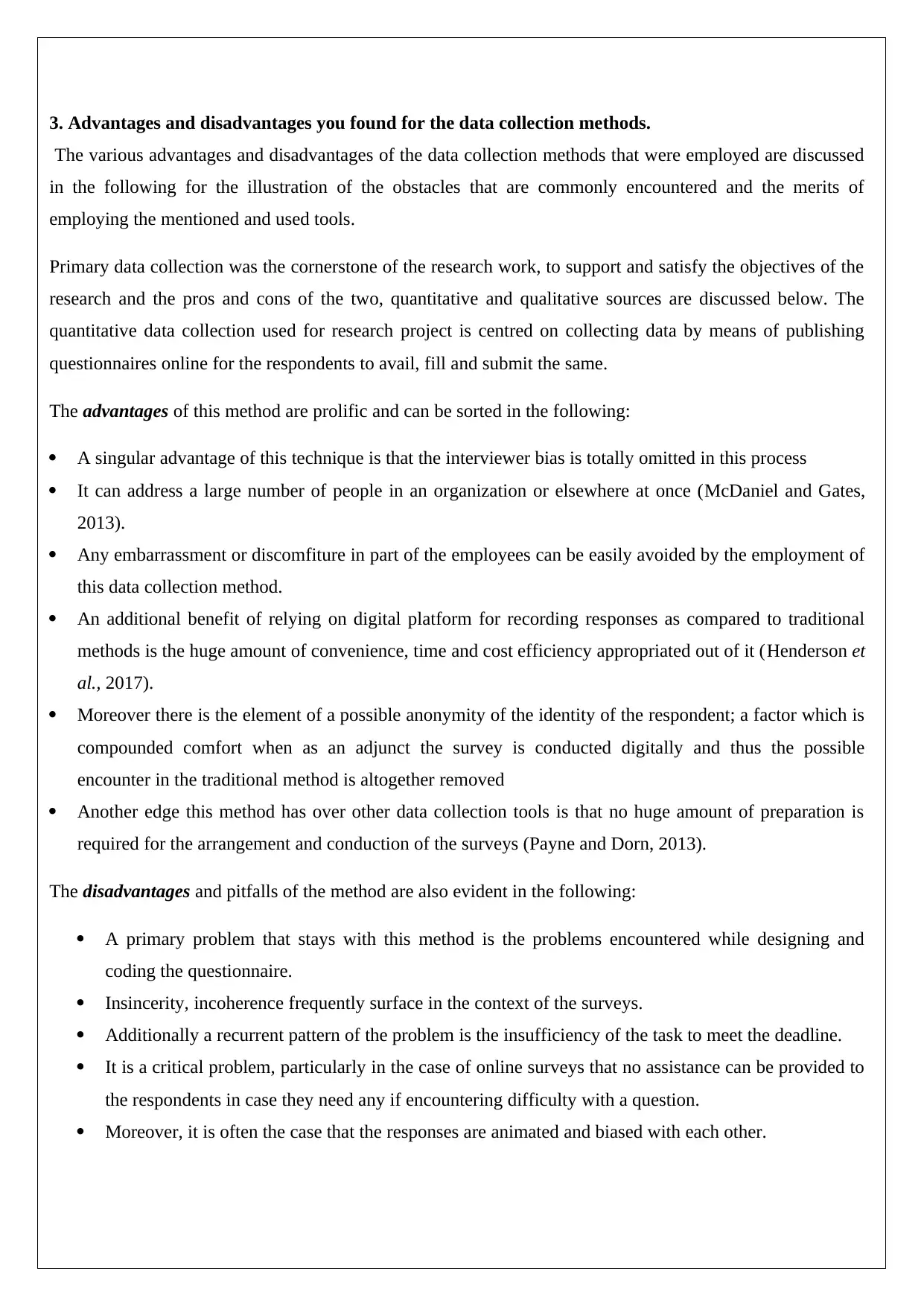
3. Advantages and disadvantages you found for the data collection methods.
The various advantages and disadvantages of the data collection methods that were employed are discussed
in the following for the illustration of the obstacles that are commonly encountered and the merits of
employing the mentioned and used tools.
Primary data collection was the cornerstone of the research work, to support and satisfy the objectives of the
research and the pros and cons of the two, quantitative and qualitative sources are discussed below. The
quantitative data collection used for research project is centred on collecting data by means of publishing
questionnaires online for the respondents to avail, fill and submit the same.
The advantages of this method are prolific and can be sorted in the following:
A singular advantage of this technique is that the interviewer bias is totally omitted in this process
It can address a large number of people in an organization or elsewhere at once (McDaniel and Gates,
2013).
Any embarrassment or discomfiture in part of the employees can be easily avoided by the employment of
this data collection method.
An additional benefit of relying on digital platform for recording responses as compared to traditional
methods is the huge amount of convenience, time and cost efficiency appropriated out of it (Henderson et
al., 2017).
Moreover there is the element of a possible anonymity of the identity of the respondent; a factor which is
compounded comfort when as an adjunct the survey is conducted digitally and thus the possible
encounter in the traditional method is altogether removed
Another edge this method has over other data collection tools is that no huge amount of preparation is
required for the arrangement and conduction of the surveys (Payne and Dorn, 2013).
The disadvantages and pitfalls of the method are also evident in the following:
A primary problem that stays with this method is the problems encountered while designing and
coding the questionnaire.
Insincerity, incoherence frequently surface in the context of the surveys.
Additionally a recurrent pattern of the problem is the insufficiency of the task to meet the deadline.
It is a critical problem, particularly in the case of online surveys that no assistance can be provided to
the respondents in case they need any if encountering difficulty with a question.
Moreover, it is often the case that the responses are animated and biased with each other.
The various advantages and disadvantages of the data collection methods that were employed are discussed
in the following for the illustration of the obstacles that are commonly encountered and the merits of
employing the mentioned and used tools.
Primary data collection was the cornerstone of the research work, to support and satisfy the objectives of the
research and the pros and cons of the two, quantitative and qualitative sources are discussed below. The
quantitative data collection used for research project is centred on collecting data by means of publishing
questionnaires online for the respondents to avail, fill and submit the same.
The advantages of this method are prolific and can be sorted in the following:
A singular advantage of this technique is that the interviewer bias is totally omitted in this process
It can address a large number of people in an organization or elsewhere at once (McDaniel and Gates,
2013).
Any embarrassment or discomfiture in part of the employees can be easily avoided by the employment of
this data collection method.
An additional benefit of relying on digital platform for recording responses as compared to traditional
methods is the huge amount of convenience, time and cost efficiency appropriated out of it (Henderson et
al., 2017).
Moreover there is the element of a possible anonymity of the identity of the respondent; a factor which is
compounded comfort when as an adjunct the survey is conducted digitally and thus the possible
encounter in the traditional method is altogether removed
Another edge this method has over other data collection tools is that no huge amount of preparation is
required for the arrangement and conduction of the surveys (Payne and Dorn, 2013).
The disadvantages and pitfalls of the method are also evident in the following:
A primary problem that stays with this method is the problems encountered while designing and
coding the questionnaire.
Insincerity, incoherence frequently surface in the context of the surveys.
Additionally a recurrent pattern of the problem is the insufficiency of the task to meet the deadline.
It is a critical problem, particularly in the case of online surveys that no assistance can be provided to
the respondents in case they need any if encountering difficulty with a question.
Moreover, it is often the case that the responses are animated and biased with each other.
⊘ This is a preview!⊘
Do you want full access?
Subscribe today to unlock all pages.

Trusted by 1+ million students worldwide
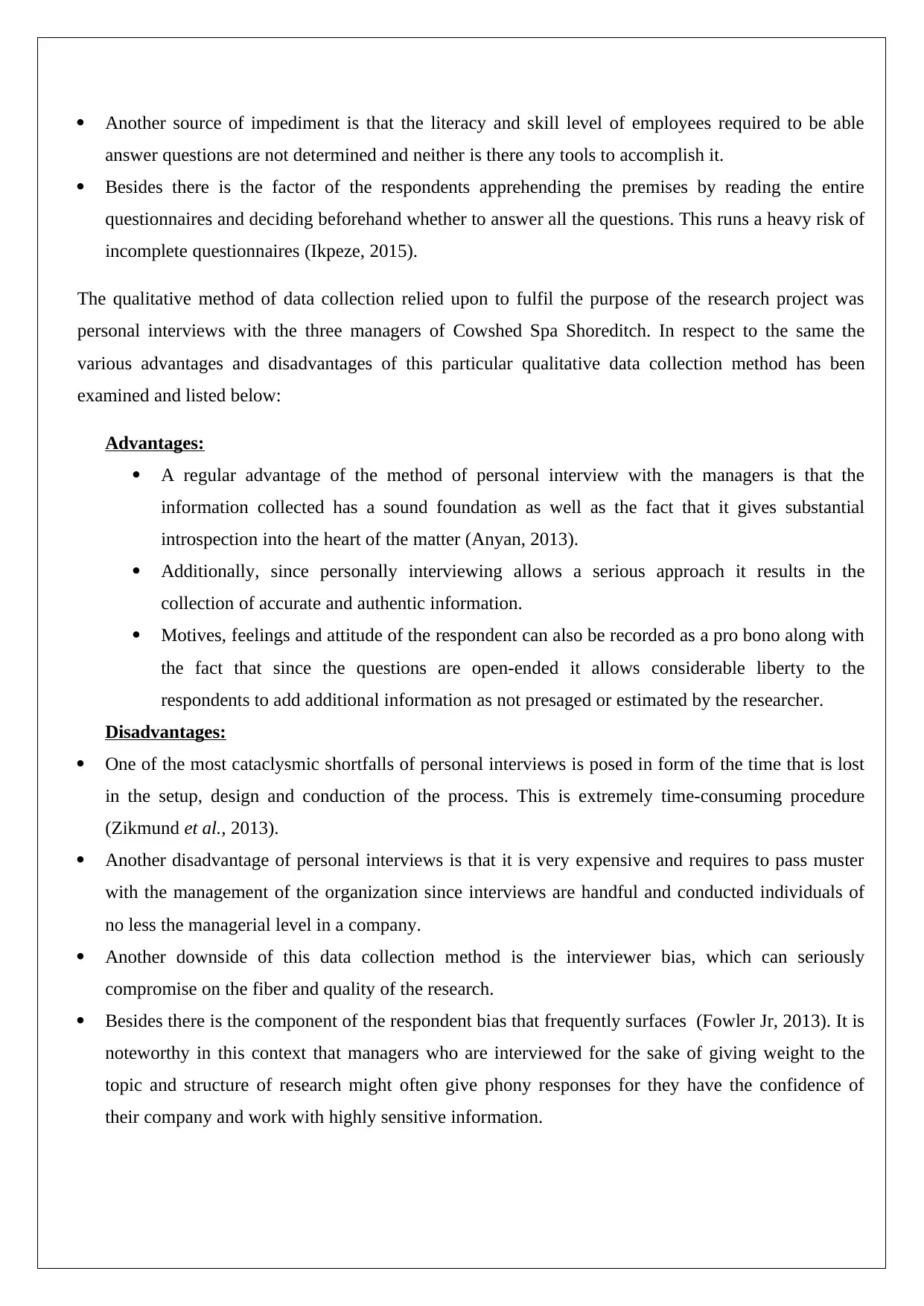
Another source of impediment is that the literacy and skill level of employees required to be able
answer questions are not determined and neither is there any tools to accomplish it.
Besides there is the factor of the respondents apprehending the premises by reading the entire
questionnaires and deciding beforehand whether to answer all the questions. This runs a heavy risk of
incomplete questionnaires (Ikpeze, 2015).
The qualitative method of data collection relied upon to fulfil the purpose of the research project was
personal interviews with the three managers of Cowshed Spa Shoreditch. In respect to the same the
various advantages and disadvantages of this particular qualitative data collection method has been
examined and listed below:
Advantages:
A regular advantage of the method of personal interview with the managers is that the
information collected has a sound foundation as well as the fact that it gives substantial
introspection into the heart of the matter (Anyan, 2013).
Additionally, since personally interviewing allows a serious approach it results in the
collection of accurate and authentic information.
Motives, feelings and attitude of the respondent can also be recorded as a pro bono along with
the fact that since the questions are open-ended it allows considerable liberty to the
respondents to add additional information as not presaged or estimated by the researcher.
Disadvantages:
One of the most cataclysmic shortfalls of personal interviews is posed in form of the time that is lost
in the setup, design and conduction of the process. This is extremely time-consuming procedure
(Zikmund et al., 2013).
Another disadvantage of personal interviews is that it is very expensive and requires to pass muster
with the management of the organization since interviews are handful and conducted individuals of
no less the managerial level in a company.
Another downside of this data collection method is the interviewer bias, which can seriously
compromise on the fiber and quality of the research.
Besides there is the component of the respondent bias that frequently surfaces (Fowler Jr, 2013). It is
noteworthy in this context that managers who are interviewed for the sake of giving weight to the
topic and structure of research might often give phony responses for they have the confidence of
their company and work with highly sensitive information.
answer questions are not determined and neither is there any tools to accomplish it.
Besides there is the factor of the respondents apprehending the premises by reading the entire
questionnaires and deciding beforehand whether to answer all the questions. This runs a heavy risk of
incomplete questionnaires (Ikpeze, 2015).
The qualitative method of data collection relied upon to fulfil the purpose of the research project was
personal interviews with the three managers of Cowshed Spa Shoreditch. In respect to the same the
various advantages and disadvantages of this particular qualitative data collection method has been
examined and listed below:
Advantages:
A regular advantage of the method of personal interview with the managers is that the
information collected has a sound foundation as well as the fact that it gives substantial
introspection into the heart of the matter (Anyan, 2013).
Additionally, since personally interviewing allows a serious approach it results in the
collection of accurate and authentic information.
Motives, feelings and attitude of the respondent can also be recorded as a pro bono along with
the fact that since the questions are open-ended it allows considerable liberty to the
respondents to add additional information as not presaged or estimated by the researcher.
Disadvantages:
One of the most cataclysmic shortfalls of personal interviews is posed in form of the time that is lost
in the setup, design and conduction of the process. This is extremely time-consuming procedure
(Zikmund et al., 2013).
Another disadvantage of personal interviews is that it is very expensive and requires to pass muster
with the management of the organization since interviews are handful and conducted individuals of
no less the managerial level in a company.
Another downside of this data collection method is the interviewer bias, which can seriously
compromise on the fiber and quality of the research.
Besides there is the component of the respondent bias that frequently surfaces (Fowler Jr, 2013). It is
noteworthy in this context that managers who are interviewed for the sake of giving weight to the
topic and structure of research might often give phony responses for they have the confidence of
their company and work with highly sensitive information.
Paraphrase This Document
Need a fresh take? Get an instant paraphrase of this document with our AI Paraphraser
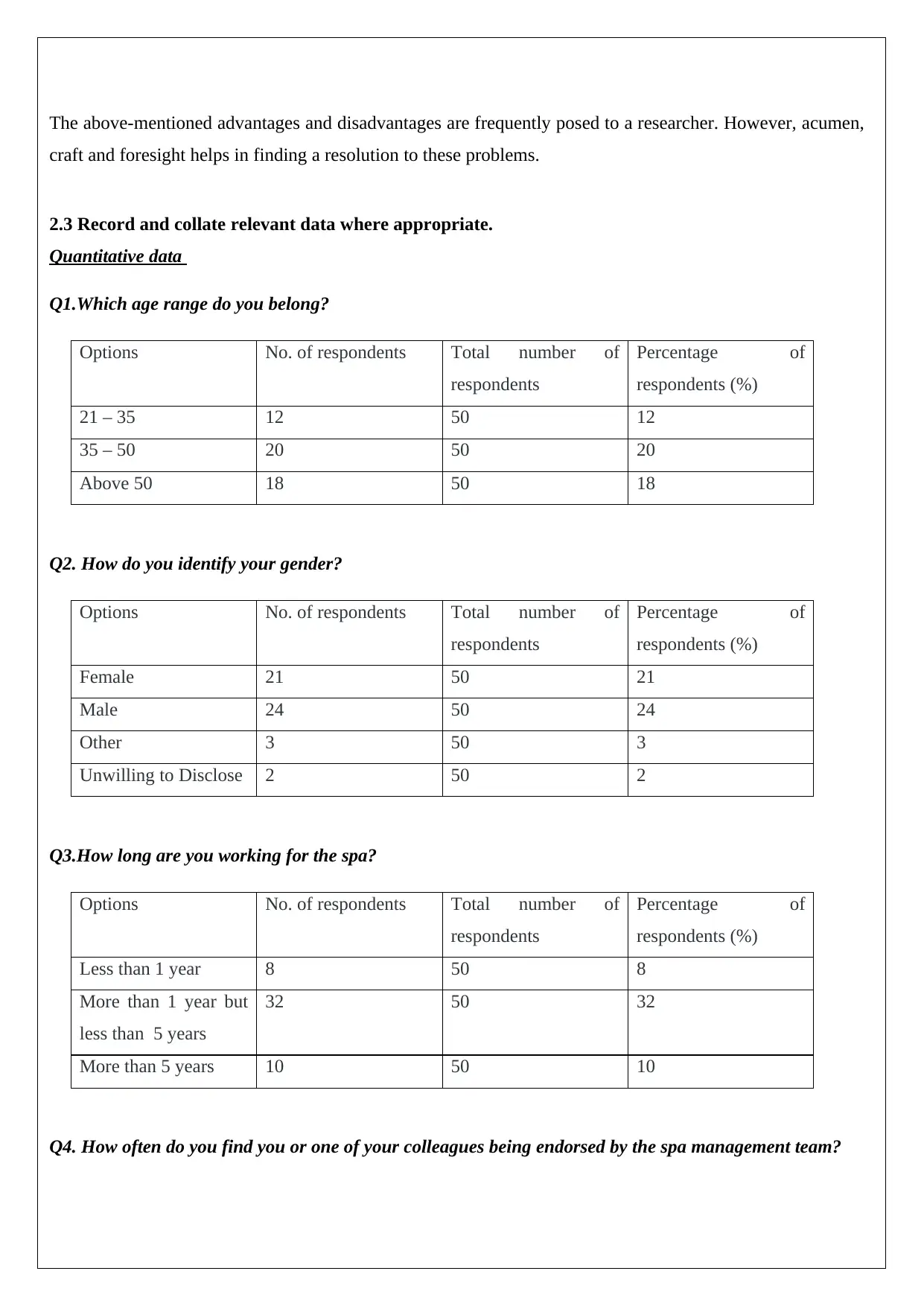
The above-mentioned advantages and disadvantages are frequently posed to a researcher. However, acumen,
craft and foresight helps in finding a resolution to these problems.
2.3 Record and collate relevant data where appropriate.
Quantitative data
Q1.Which age range do you belong?
Options No. of respondents Total number of
respondents
Percentage of
respondents (%)
21 – 35 12 50 12
35 – 50 20 50 20
Above 50 18 50 18
Q2. How do you identify your gender?
Options No. of respondents Total number of
respondents
Percentage of
respondents (%)
Female 21 50 21
Male 24 50 24
Other 3 50 3
Unwilling to Disclose 2 50 2
Q3.How long are you working for the spa?
Options No. of respondents Total number of
respondents
Percentage of
respondents (%)
Less than 1 year 8 50 8
More than 1 year but
less than 5 years
32 50 32
More than 5 years 10 50 10
Q4. How often do you find you or one of your colleagues being endorsed by the spa management team?
craft and foresight helps in finding a resolution to these problems.
2.3 Record and collate relevant data where appropriate.
Quantitative data
Q1.Which age range do you belong?
Options No. of respondents Total number of
respondents
Percentage of
respondents (%)
21 – 35 12 50 12
35 – 50 20 50 20
Above 50 18 50 18
Q2. How do you identify your gender?
Options No. of respondents Total number of
respondents
Percentage of
respondents (%)
Female 21 50 21
Male 24 50 24
Other 3 50 3
Unwilling to Disclose 2 50 2
Q3.How long are you working for the spa?
Options No. of respondents Total number of
respondents
Percentage of
respondents (%)
Less than 1 year 8 50 8
More than 1 year but
less than 5 years
32 50 32
More than 5 years 10 50 10
Q4. How often do you find you or one of your colleagues being endorsed by the spa management team?
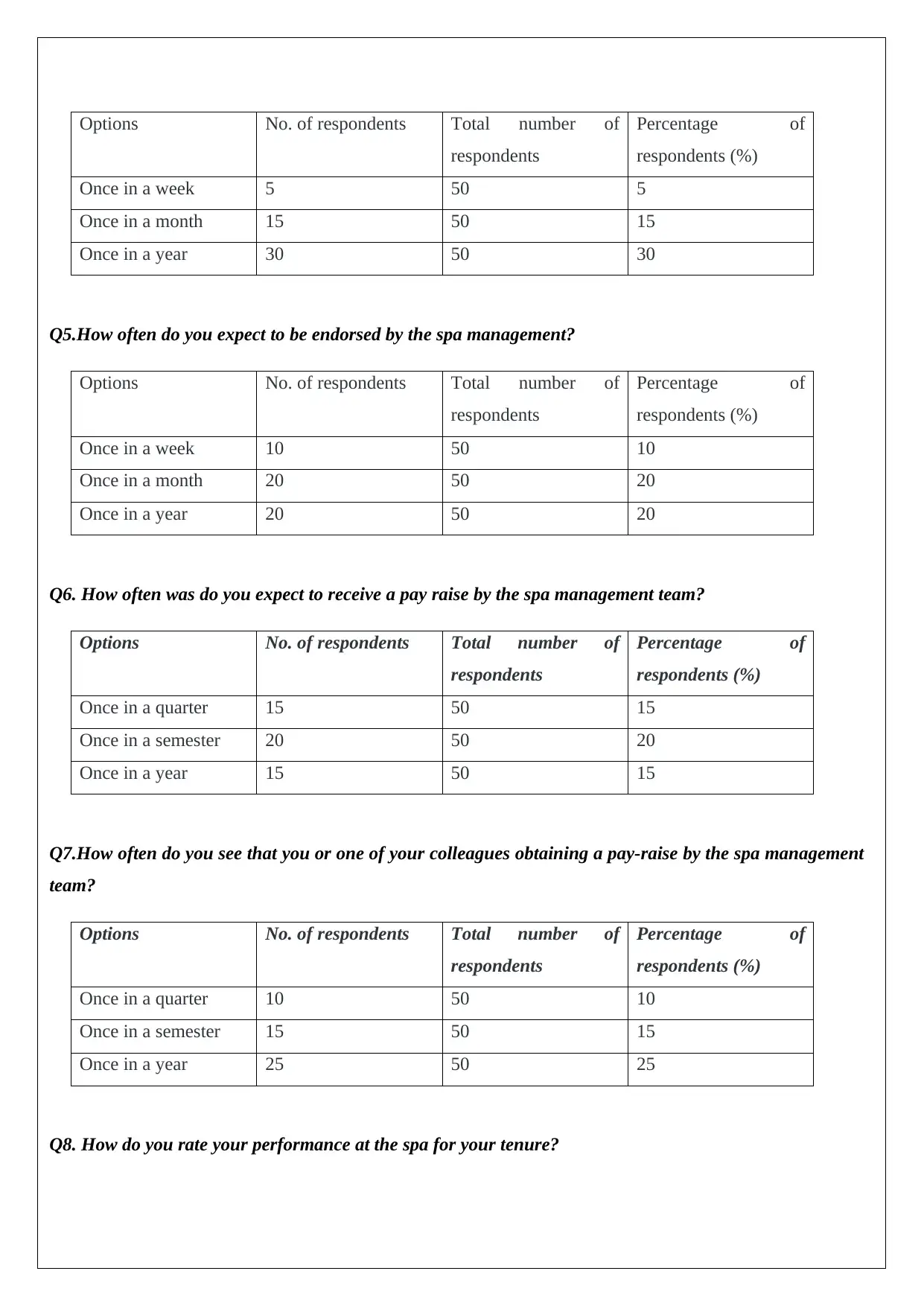
Options No. of respondents Total number of
respondents
Percentage of
respondents (%)
Once in a week 5 50 5
Once in a month 15 50 15
Once in a year 30 50 30
Q5.How often do you expect to be endorsed by the spa management?
Options No. of respondents Total number of
respondents
Percentage of
respondents (%)
Once in a week 10 50 10
Once in a month 20 50 20
Once in a year 20 50 20
Q6. How often was do you expect to receive a pay raise by the spa management team?
Options No. of respondents Total number of
respondents
Percentage of
respondents (%)
Once in a quarter 15 50 15
Once in a semester 20 50 20
Once in a year 15 50 15
Q7.How often do you see that you or one of your colleagues obtaining a pay-raise by the spa management
team?
Options No. of respondents Total number of
respondents
Percentage of
respondents (%)
Once in a quarter 10 50 10
Once in a semester 15 50 15
Once in a year 25 50 25
Q8. How do you rate your performance at the spa for your tenure?
respondents
Percentage of
respondents (%)
Once in a week 5 50 5
Once in a month 15 50 15
Once in a year 30 50 30
Q5.How often do you expect to be endorsed by the spa management?
Options No. of respondents Total number of
respondents
Percentage of
respondents (%)
Once in a week 10 50 10
Once in a month 20 50 20
Once in a year 20 50 20
Q6. How often was do you expect to receive a pay raise by the spa management team?
Options No. of respondents Total number of
respondents
Percentage of
respondents (%)
Once in a quarter 15 50 15
Once in a semester 20 50 20
Once in a year 15 50 15
Q7.How often do you see that you or one of your colleagues obtaining a pay-raise by the spa management
team?
Options No. of respondents Total number of
respondents
Percentage of
respondents (%)
Once in a quarter 10 50 10
Once in a semester 15 50 15
Once in a year 25 50 25
Q8. How do you rate your performance at the spa for your tenure?
⊘ This is a preview!⊘
Do you want full access?
Subscribe today to unlock all pages.

Trusted by 1+ million students worldwide
1 out of 41
Related Documents
Your All-in-One AI-Powered Toolkit for Academic Success.
+13062052269
info@desklib.com
Available 24*7 on WhatsApp / Email
![[object Object]](/_next/static/media/star-bottom.7253800d.svg)
Unlock your academic potential
Copyright © 2020–2025 A2Z Services. All Rights Reserved. Developed and managed by ZUCOL.




